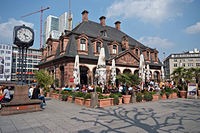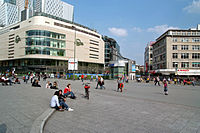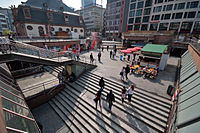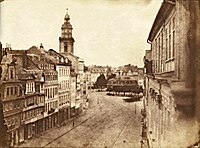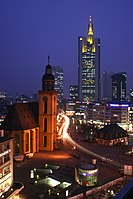Hauptwache (Frankfurt am Main)
| Hauptwache | |
|---|---|
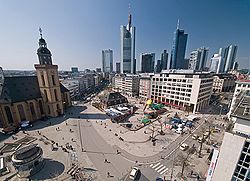 The Hauptwache and the plaza as seen from the Kaufhof's roof garden in 2010 | |
 | |
| Former names |
|
| General information | |
| Status | Rebuild |
| Type | Guard building with guard rooms and prison |
| Architectural style | Baroque |
| Location | Altstadt |
| Address | An der Hauptwache 15 |
| Town or city | Frankfurt |
| Country | Germany |
| Coordinates | 50°06′48″N 8°40′44″E / 50.11333°N 8.67889°E |
| Current tenants | Café (since 1905)[1] |
| Construction started | 1729 |
| Completed | 1730 |
| Opened | 1954 (rebuild) |
| Renovated | 1954 |
| Destroyed | 1944[1] |
| Design and construction | |
| Architect(s) | Johann Jakob Samhaimer[3][4] |
| Known for | Prison for Schinderhannes[1][2] |
| Other information | |
| Public transit access | |
The Hauptwache (Main Guardroom) is a central point of Frankfurt am Main and is one of the most famous plazas (German: An der Hauptwache) in the city. The original name Schillerplatz was superseded in the early 1900s. It lies to the west of Konstablerwache with both squares linked by the Zeil, the central shopping area of the city.
The Hauptwache building
[edit]The Baroque building which gave the square its name was built in 1730. It was the headquarters of the city's Stadtwehr militia when Frankfurt was an independent city state (→ Free City of Frankfurt) and also contained a prison. In the 18th century Frankfurt still had city walls and its own army. Until 1864 the place surrounding the building was called Paradeplatz reflecting its military function.[5]
In 1833 during the Frankfurter Wachensturm, the Hauptwache and the Konstablerwache were stormed in a failed effort by a small revolutionary force of native citizens, among others Gustav Koerner, and some people from different locations in Germany. When Prussia annexed the city in 1866 and took over military activities, the Hauptwache lost this role.
The prison remained and the Hauptwache also became a police station. In 1904, the building was used as a café and remains one to this day. It was the scene of the Hauptwache incident when French troops opened fire on students protesting against the French occupation of Frankfurt on 7 April 1920.[6] Heavily burned in World War II bombing, it was reopened in a provisional form with an altered roof in 1954. In 1967, with the building of the U-Bahn tunnel through the city, it was dismantled so it could be moved and rebuilt over the new underground U-Bahn station.[7][8][9] The plaza has undergone another major renovation when the S-Bahn station for suburban trains was opened in 1978.
Hauptwache station serves as one of the most important crosspoints of the Frankfurt public transport system. Eight of nine S-Bahn lines serve the station as well as six of nine U-Bahn lines.
The Plaza
[edit]The plaza "An der Hauptwache" has been reformed several times. Its current appearance is marked by a sunken terrace leading down to underground pedestrian area with shops and the public transport station. Frankfurters call the sunken area "das Loch" (the Hole).[10]
The plaza contains a number of different architectural styles. It is towered above and dominated by St. Catherine's Church. Apart from the baroque Hauptwache itself, the surrounding buildings are mostly new architecture because of the damage from the war.
Connecting streets
[edit]- Shopping district streets
- Thoroughfare Streets
- Straßenzug Roßmarkt/Kaiserstraße
- Große Eschenheimer Straße
Gallery
[edit]-
The former guard-house with a café (front side)
-
The Hauptwache plaza with the Kaufhof department store
-
The Hole in the Hauptwache plaza
-
Hauptwache in 1846, by William Fox Talbot
-
The Hauptwache at night, seen from the Kaufhof's roof garden
References
[edit]- ^ a b c Bittner, Matthias (29 June 2021). "Stadtteilgeschichte: Zehn Jahre ruhte der Cafebetrieb in der Frankfurter Hauptwache". fnp.de (in German). Archived from the original on 20 December 2022. Retrieved 20 December 2022.
- ^ Rieb, Bruno (10 January 2020). "Schinderhannes – Christian Vogel entzaubert den Mythos". landbote.info (in German). Archived from the original on 20 December 2022. Retrieved 20 December 2022.
- ^ "Samhammer, Johann Jakob". Frankfurter Personenlexikon (in German). Archived from the original on 20 December 2022. Retrieved 20 December 2022.
- ^ Gwinner, P.F. (1862). Kunst und Künstler in Frankfurt am Main: vom dreizehnten Jahrhundert bis zur Eröffnung des Städel'schen Kunstinstituts. Bibl. du Mis de Laborde (in German). J. Baer. p. 300. Archived from the original on 7 December 2023. Retrieved 20 December 2022.
- ^ "Rund um die Hauptwache" [Around the Main Guard] (PDF) (in German). Karmeliterkloster, Frankfurt am Main: Institut für Stadtgeschichte. 2004. p. 8. Archived from the original (PDF) on 24 September 2015. Retrieved 1 September 2013.
- ^ "Tote und Verletzte an der Frankfurter Hauptwache, 7. April 1920 LAGIS Hessen". Zeitgeschichte in Hessen (in German). Archived from the original on 20 December 2022. Retrieved 20 December 2022.
- ^ "Frankfurter Magistrat beschließt zeitweiligen Abriss der Hauptwache, 25. Januar 1966 : LAGIS Hessen". Zeitgeschichte in Hessen (in German). Archived from the original on 20 December 2022. Retrieved 20 December 2022.
- ^ "Baubeginn für den U-Bahnbahnhof an der Frankfurter Hauptwache, 5. August 1965 : LAGIS Hessen". Zeitgeschichte in Hessen (in German). Archived from the original on 20 December 2022. Retrieved 20 December 2022.
- ^ "Eröffnung der U-Bahn in Frankfurt, 4. Oktober 1968 : LAGIS Hessen". Zeitgeschichte in Hessen (in German). Archived from the original on 20 December 2022. Retrieved 20 December 2022.
- ^ Manus, Christoph (30 September 2021). "Frankfurt: Was geschieht mit dem Loch an der Hauptwache?". Frankfurter Rundschau (in German). Archived from the original on 20 December 2022. Retrieved 20 December 2022.
External links
[edit]![]() Media related to Hauptwache and An der Hauptwache at Wikimedia Commons
Media related to Hauptwache and An der Hauptwache at Wikimedia Commons

